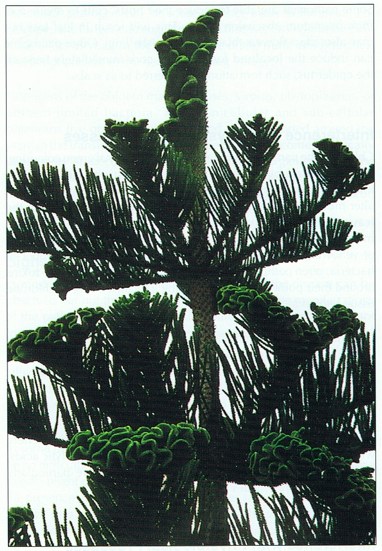PESTS AND DISEASES OF FORESTRY IN NEW ZEALAND
Fasciated shoot-tips on Norfolk Island pine Araucaria heterophylla
Scion is the leading provider of forest-related knowledge in New Zealand
Formerly known as the Forest Research Institute, Scion has been a leader in research relating to forest health for over 50 years. The Rotorua-based Crown Research Institute continues to provide science that will protect all forests from damage caused by insect pests, pathogens and weeds. The information presented below arises from these research activities.
From Scion publication Forest Research Bulletin 220 An Introduction to The Diseases of Forest and Amenity Trees in New Zealand,
G.S.Ridley and M.A. Dick 2001.
Pathogens can induce many changes in a plant's physiology, cell division and growth, and tissue morphology. These effects may be immediate or there may be delayed impairment of plant functions after infection.

Interference with Cell Division and Growth Pathogens may cause a plant to produce abnormally small cells (hypoplasia) or abnormally large cells (hypertrophy), or they may cause excessive cell division (hyperplasia), or there may be any combination of the three. Pathogens may also stop cell division (atrophy), or cause the premature differentiation of cells. Dwarfing is the result of general tissue hypoplasia. Leaf puckering is the result of localised hypertrophy and/or hyperplasia in the upper cell layers of leaves; if, however, it occurs across the entire leaf surface, curling will result. Excessive elongation and division of the internode cells will result in etiolation, whereas a reduction in cell division and growth will result in suppression of the internodes and resetting. Excessive elongation of the upper cells of the petiole will result in epinasty, and the excessive accumulation of water and consequent inflation of localised pockets of epidermal cells results in blisters (oedema) which may rupture.
Hyperplasia of parenchyma cells produces galls or tumours that do not resemble any part of a healthy plant. Some gall and tumour formation is accompanied by the production of abundant apical meristems over its surface and may result in a witches' broom. Hyperplasia is also responsible for producing smooth, swollen, callus tissue around cankers, and the characteristic fanned and flattened stems offasciated shoot tips (Fig. 11). Often hyperplasia is linked with hypertrophy.
This information is intended for general interest only. It is not intended to be a substitute for specific specialist advice on any matter and should not be relied on for that purpose. Scion will not be liable for any direct, indirect, incidental, special, consequential or exemplary damages, loss of profits, or any other intangible losses that result from using the information provided on this site.
(Scion is the trading name of the New Zealand Forest Research Institute Limited.)



